
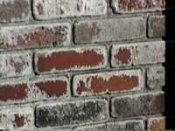
Is it really efflorescence? Please read the entire page to confirm if it is "true" efflorescence or could it be: a grout additive coming out, a peeling sealer, etc. These all are very similar looking to efflorescence.
This information applies to efflorescence on all surface types,
including brick, block, tile, grout, slate, stone, concrete work, pavers, limestone, marble, granite, etc.
Efflorescence can be heavy as shown in these pictures or very light deposits in the pores of concrete products (block, manufactured stone, brick, pavers) that creates the appearance of fading.
Where it comes from! -- How to remove it! -- How to stop it! Where does it come from? Two conditions must be present to create efflorescence:2. Water moving through the material to carry the salts to the surface. The water evaporates and leaves the white powder behind. Some surfacing products are more prone to have efflorescence because:
. They might be more permeable and promote water travel.
. They might tend to have higher water soluble salts in some batches. Despite the best efforts of surfacing manufacturers to minimize water soluble salts in their products, they use materials from the earth that can vary from batch to batch.
. THROUGH - Entering from behind (bad flashing, caulking, leaks) or underneath (water from the earth migrating up) and traveling through.
. "Crystalline" efflorescence. When powdery efflorescence goes through cycles of being deposited on the surface - re dissolved when new water occurs - drying out - new water - etc. it can form crystals. The crystals become tightly bonded to the surface. The crystals do not have to be thick. A light haze that is still there after using "Efflorescence Treatment" will be light crystal formation and is treated as described below.

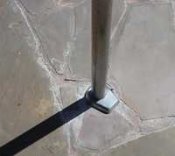



 Before
Before
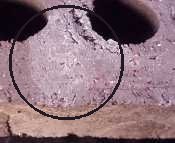
clay brick - charcoal color After
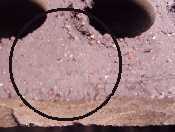
after 15 minutes "Efflorescence Treatment" is not a cleaner that must be rinsed or removed.
"Efflorescence Treatment" carries the salts below the surface.
"Efflorescence Treatment" enhances the surface color.
See the "Efflorescence Treatment" page in the PRODUCTS section for more pictures and details.
Note: If there is no fizzing reaction and the crystals are not removed, this is not efflorescence.
. Possibility #1: See Problem Solving for "additive" bleed out.
. Possibility #2: There are a few brick manufactured in the southeastern United States that can bleed out a chemical deposit that is very difficult to remove. Removal options may be limited to a type of sand or shot blasting.
. Then - treat with Aldon Efflorescence Treatment for any remaining powdery efflorescence and to enhance surface color.
This concrete paver shows efflorescence, crystalline efflorescence, and scuffing.
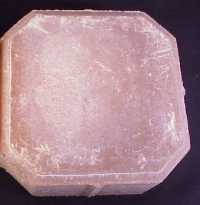
First with "Grout Residue Remover" to remove crystalline efflorescence and scuff marks.
Then treated with "Efflorescence Treatment". Note how the color has been restored.

After treating the surface to restore its appearance, you can prevent future efflorescence by applying one of the penetrating sealers per directions. This is true even if the water is coming from behind or subsurface and cannot be stopped. This is a laboratory Test Proving: Efflorescence Can Be Stopped By An Appropriate Sealer! Test Procedures:
. Using a red clay brick - designation: "Common". The dark color and high permeability show efflorescence easily.
. The brick is partially submerged in a pan of water with 5% sodium carbonate (water soluble salt).
. The Pan is covered with plastic wrap with a hole cut at the brick face only. This forces water to migrate through the brick.
. A fan is blowing air across the surface to accelerate the water migration.
. These conditions are worse than most real world situations.
. All brick are from the same pallet to minimize differences.
. The "control" brick shows what happens with no sealer. "Control" Brick | Unsealed - "raw" | At 2 minutes | No efflorescence


Test #1
A = "SBS Sealer"
B = raw
C = "Porous Stone Sealer "
(The same result is achieved with "Penetrating Paver Sealer".)
Result: Efflorescence stopped!

 Test #2
Test #2
A = "Mexiglaze"
B = raw
Result:Efflorescence stopped!
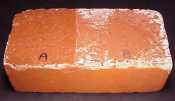 Test #3
Test #3
A = "Same Day"
B = raw
C = "Crystal Glaze"
Result: Efflorescence stopped!

*Note arrow and see below. * The arrow on Test #3 picture points to slight efflorescence on the left edge of the sealerd section. This is a "coating" type sealer and does not penetrate to the degree of the others, it is somewhat less effective in stopping efflorescence if the water source is subsurface as in this test. However, as it will impede the entrance of outside water (rain, sprinkler), the in/out cycle of that water source is broken - which stops efflorescence. How does this work?
The petroleum solvent penetrating sealers can create a barrier below any absorbent surface that allows water vapor to "breathe" out, but stops the water soluble salt molecules from migrating out.
As you saw above, you need the sealer penetrated down below the surface to stop efflorescence. The problem with then painting the surface is that the sealer can be a "bond breaker" and might not provide good adhesion for the paint.
Note: There are paint store products termed "primer/sealer" for paint. These are a surface coating preparation step for paint adhesion and finish. They are not a sealer of the types that Aldon manufactured that function as a final sealer that provides multiple benefits of the kind we have described, including the creation of an efflorescence barrier below the surface.
If you really must paint the surface in addition to sealing it, take the gloss down to the surface and then use sandpaper to roughen up the surface to improve the "grabbing" ability of the paint.